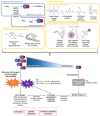Recent Developments in Nitric Oxide Donors and Delivery for Antimicrobial and Anti-Biofilm Applications
- PMID: 35163933
- PMCID: PMC8839391
- DOI: 10.3390/molecules27030674
Recent Developments in Nitric Oxide Donors and Delivery for Antimicrobial and Anti-Biofilm Applications
Abstract
The use of nitric oxide (NO) is emerging as a promising, novel approach for the treatment of antibiotic resistant bacteria and biofilm infections. Depending on the concentration, NO can induce biofilm dispersal, increase bacteria susceptibility to antibiotic treatment, and induce cell damage or cell death via the formation of reactive oxygen or reactive nitrogen species. The use of NO is, however, limited by its reactivity, which can affect NO delivery to its target site and result in off-target effects. To overcome these issues, and enable spatial or temporal control over NO release, various strategies for the design of NO-releasing materials, including the incorporation of photo-activable, charge-switchable, or bacteria-targeting groups, have been developed. Other strategies have focused on increased NO storage and delivery by encapsulation or conjugation of NO donors within a single polymeric framework. This review compiles recent developments in NO drugs and NO-releasing materials designed for applications in antimicrobial or anti-biofilm treatment and discusses limitations and variability in biological responses in response to the use of NO for bacterial eradiation.
Keywords: antibacterial; biofilm; nitric oxide; nitric oxide donors.
Conflict of interest statement
The authors declare no conflict of interest.
Figures




Similar articles
-
Nitric oxide-mediated dispersal in single- and multi-species biofilms of clinically and industrially relevant microorganisms.Microb Biotechnol. 2009 May;2(3):370-8. doi: 10.1111/j.1751-7915.2009.00098.x. Epub 2009 Mar 13. Microb Biotechnol. 2009. PMID: 21261931 Free PMC article.
-
Involvement of nitric oxide in biofilm dispersal of Pseudomonas aeruginosa.J Bacteriol. 2006 Nov;188(21):7344-53. doi: 10.1128/JB.00779-06. J Bacteriol. 2006. PMID: 17050922 Free PMC article.
-
Overview of the effects and mechanisms of NO and its donors on biofilms.Crit Rev Food Sci Nutr. 2025;65(4):647-666. doi: 10.1080/10408398.2023.2279687. Epub 2023 Nov 9. Crit Rev Food Sci Nutr. 2025. PMID: 37942962 Review.
-
Furoxan Nitric Oxide Donors Disperse Pseudomonas aeruginosa Biofilms, Accelerate Growth, and Repress Pyoverdine Production.ACS Chem Biol. 2017 Aug 18;12(8):2097-2106. doi: 10.1021/acschembio.7b00256. Epub 2017 Jun 29. ACS Chem Biol. 2017. PMID: 28628310
-
Nitric Oxide-Releasing Macromolecular Scaffolds for Antibacterial Applications.Adv Healthc Mater. 2018 Jul;7(13):e1800155. doi: 10.1002/adhm.201800155. Epub 2018 May 14. Adv Healthc Mater. 2018. PMID: 29756275 Free PMC article. Review.
Cited by
-
Nanotechnology-Based Drug Delivery Systems to Control Bacterial-Biofilm-Associated Lung Infections.Pharmaceutics. 2023 Nov 3;15(11):2582. doi: 10.3390/pharmaceutics15112582. Pharmaceutics. 2023. PMID: 38004561 Free PMC article. Review.
-
Synthesis and Characterization of a Sustained Nitric Oxide-Releasing Orthodontic Elastomeric Chain for Antimicrobial Action.Int J Mol Sci. 2024 Jun 26;25(13):6982. doi: 10.3390/ijms25136982. Int J Mol Sci. 2024. PMID: 39000090 Free PMC article.
-
Biofilm matrix: a multifaceted layer of biomolecules and a defensive barrier against antimicrobials.Arch Microbiol. 2024 Oct 14;206(11):432. doi: 10.1007/s00203-024-04157-3. Arch Microbiol. 2024. PMID: 39402397 Review.
-
The nitric oxide paradox: antimicrobial and inhibitor of antibiotic efficacy.Emerg Top Life Sci. 2024 Feb 22;8(1):37-43. doi: 10.1042/ETLS20230114. Emerg Top Life Sci. 2024. PMID: 37975610 Free PMC article.
-
Modulating Nitric Oxide: Implications for Cytotoxicity and Cytoprotection.Antioxidants (Basel). 2024 Apr 23;13(5):504. doi: 10.3390/antiox13050504. Antioxidants (Basel). 2024. PMID: 38790609 Free PMC article. Review.
References
-
- Srey S., Jahid I.K., Ha S.-D. Biofilm formation in food industries: A food safety concern. Food Control. 2013;31:572–585. doi: 10.1016/j.foodcont.2012.12.001. - DOI
-
- De Carvalho C.C. Marine Biofilms: A Successful Microbial Strategy with Economic Implications. Front. Mar. Sci. 2018;5:126. doi: 10.3389/fmars.2018.00126. - DOI
Publication types
MeSH terms
Substances
Grants and funding
LinkOut - more resources
Full Text Sources
Other Literature Sources
Medical

